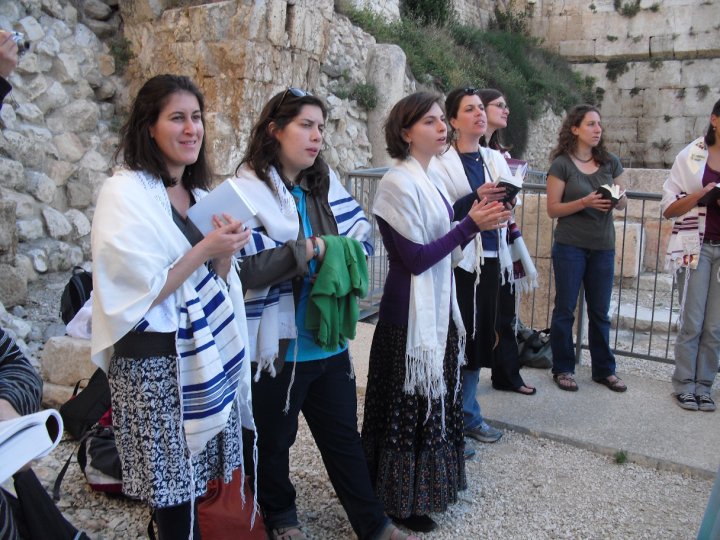
Speak to the Israelite people and instruct them to make for themselves tzitzit on the corners of their garments throughout the ages; let them attach a cord of blue to the fringe of each corner. (Numbers 15:38)1
You shall make fringes of the four corners of the garment with which you cover yourself. (Deuteronomy 22:12)
When God spoke to Moses and brought down Torah one of the mitzvot Jews are to perform in perpetuity is the mitzvah of tzitzit. As seen in Numbers chapter 15 this mitzvah was to be performed by every Jew throughout the ages.
This mitzvah – contrary to Orthodox opinion – is to be carried out by both males and females within the Jewish community. According to the rules of Hebrew grammar, if a mixed group is being addressed the masculine word forms will be used. In this case we see that Moses is told to speak to B’nei Yisrael. Strictly speaking this means the “sons of Israel.” However, since this was a mixed group – consisting of male and female participants – the proper translation of B’nei Yisrael is the “children of Israel” – meaning both male and female.
According to most in the Orthodox world (and some non-Orthodox Jews) women are exempt from time-bound mitzvot. The Talmud states that women are exempt from time-bound mitzvot but are not forbidden from performing these mitzvot.
All obligations of the son upon the father, men are bound, but women are exempt. But all obligations of the father upon the son, both men and women are bound. All affirmative precepts limited to time, men are liable and women are exempt. But all affirmative precepts not limited to time are binding upon both men and women. And all negative precepts, whether limited to time or not limited to time, are binding upon both men and women; excepting, you shall not round [the corners of your heads], neither shall you mar [the corner of your beard], and, he shall not defile himself to the dead. (Talmud Bavli – Kiddushin 29a)2
The rabbis of the Talmud argue that time-bound mitzvot include sukkah, lulav, shofar, tzitzit, and tefillin. The question is asked how women can be exempt from time-bound mitzvot yet they are commanded to eat matzah during Chag HaMatzot ((Deuteronomy 16:3; Pesachim 43b), rejoicing during Sukkot (Deuteronomy 16:14), and assembling to hear the Torah read every seven years (Deuteronomy 31:12). In addition, the study of Torah, procreation, and the redemption of the firstborn are not affirmative time-bound precepts yet women are exempt from them. Rabbi Yohanan reportedly answered that “We cannot learn from general principles, even where exceptions are stated.” (Talmud Bavli – Kiddushin 33b-34a)2
So essentially there is no rationale to say why women are exempt from time-bound mitzvot. Rabbi Yohanan based the reasoning upon an example of an eruv (Kiddushin 34a) – which is of course a rabbinic precept and not found within the Tanakh. There is no valid “general principle” to state that women are in fact exempt from time-bound mitzvot. Of course, one will be told that women’s first responsibility is in the household and women are “spiritually superior” to men so they don’t need to fulfill these mitzvot. It is easy to see that both of these responses are simply pandering opinions to both women and men.
According to rabbinic literature women are not forbidden from donning tzitzit yet most of the Orthodox (and some non-Orthodox) Jews believe that it is in fact forbidden. It is clearly shown that according to the Talmud women are exempt from time-bound mitzvot (again, a concept nowhere found in Torah) but they are not forbidden from performing these mitzvot.
According to Maimonides:
Women, servants, and minors are not required by the Torah to wear tzitzit. It is, however, a Rabbinical obligation for every child who knows how to dress himself to wear tzitzit in order to educate him to fulfill mitzvot.
Women and servants who wish to wrap themselves in tzitzit may do so without reciting a blessing [which is a Rabbinic tradition and not found in Torah]. Similarly, regarding the other positive commandments which women are not required to fulfill, if they desire to fulfill them without reciting a blessing, they should not be prevented from doing so. (M.T. Tzitzit 3:9)3
We can see that, according to Maimonides, women are exempt from wearing tzitzit but they are not forbidden from doing so.
However, all these arguments against women wearing tzitzit (either through exemption or being forbidden from doing so) are against the eternal law of Torah. Both men and women are obligated to wear tzitzit according to Torah Law. We are forbidden to subtract from, or add to, the Torah. Unfortunately, this is exactly what the ancient (and modern) rabbis have done when it comes to women and the mitzvah of tzitzit.
——————–
1David Stein (ed.). JPS Hebrew-English Tanakh. Philadelphia: Jewish Publication Society, 1999.
2I. Epstein. “Tractate Kiddushin.” n.d. [http://halakhah.com/pdf/nashim/Kiddushin.pdf]
3Eliyahu Touger. “Mishneh Torah.” n.d. [http://www.chabad.org/library/article_cdo/aid/936343/jewish/Tzitzit-Chapter-Three.htm]
